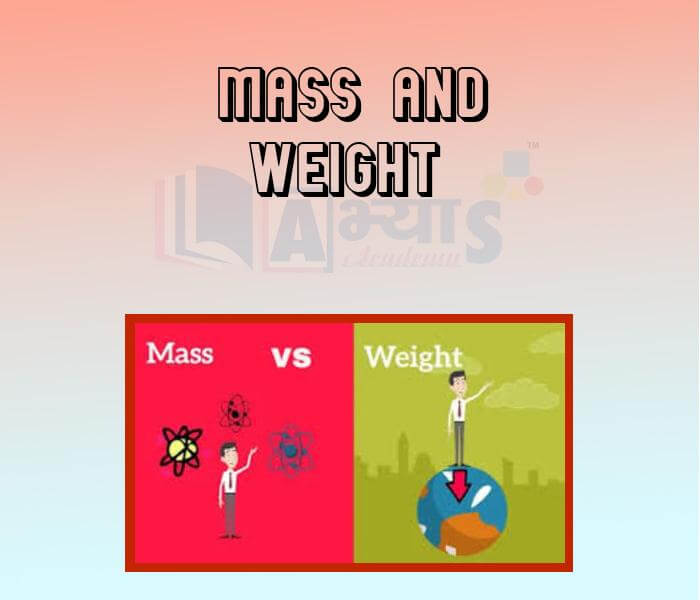Mass and Weight











Mass and Weight
Weight: of an object is the force with which it is attracted towards the Earth. Weight of an object, w = mg, where, m = mass, g = acceleration due to gravity.
Here, M = mass of the earth and R radius of the earth
From the above formula, it is clear that weight of an object will change on a planet other than the earth. Spring balance is used to measure the weight of a body and pan balance is used to measure the mass of a body.
Important points regarding weight are as follow:
Weight of an Object on the Moon: Let the mass of an object be ‘m’ and its weight on the moon be . Suppose the mass of the moon is ‘M’ and its radius be ‘R’. According to universal law of gravitation, the weight of an object on the moon will be
Let the weight of the same object on the earth be . But the mass of the earth is 100 times that of the moon and the radius of the earth is 4 times that of the moon. Weight of the object on the earth,
On dividing these equations,
Thus, the weight of an object on the moon is one-sixth of its weight on the earth.
Q. A person's mass happens to be 70 kg, while the gravity on Earth is . Find out the weight of this person?
Solution: Here, mass(m) = 70 kg and g =
As we know that weight Therefore,
Hence, the weight of the person = 686 N
Q. Conisder a heavenly body whose mass is twice that of the earth and whose radius is thrice that of the earth.What will be the weight of a book on this heavenly body, if its weight on the earth is 900 N ?
Solution: The weight of the book on the earth is
If weight on the heavenly body is
Thus,
or
A planet has its radius and mass as twice and thrice, respectively to those of earth. If an object weighs 48N on the earth, its weight on that planet will be | |||
| Right Option : B | |||
| View Explanation |
Which of the following are correct : (a) Weight of an object is the force with which it is attracted towards the Earth. (b) Weight of an object is not constant; it changes from place to place. (c) Weight of an object is constant; it cannot changes from place to place. | |||
| Right Option : A | |||
| View Explanation | |||
Weight is a _______________ quantity and in the space, where g = 0, weight of an object is ________________. | |||
| Right Option : A | |||
| View Explanation | |||
Students / Parents Reviews [10]
My experience was very good with Abhyas academy. I am studying here from 6th class and I am satisfied by its results in my life. I improved a lot here ahead of school syllabus.

Ayan Ghosh
8thAbout Abhyas metholodology the teachers are very nice and hardworking toward students.The Centre Head Mrs Anu Sethi is also a brilliant teacher.Abhyas has taught me how to overcome problems and has always taken my doubts and suppoeted me.

Shreya Shrivastava
8thMy experience with Abhyas is very good. I have learnt many things here like vedic maths and reasoning also. Teachers here first take our doubts and then there are assignments to verify our weak points.

Shivam Rana
7thAbhyas Methodology is very good. It is based on according to student and each child manages accordingly to its properly. Methodology has improved the abilities of students to shine them in future.

Manish Kumar
10thMy experience with Abhyas academy is very good. I did not think that my every subject coming here will be so strong. The main thing is that the online tests had made me learn here more things.

Hiya Gupta
8thIt was a good experience with Abhyas Academy. I even faced problems in starting but slowly and steadily overcomed. Especially reasoning classes helped me a lot.

Cheshta
10thIt has a great methodology. Students here can get analysis to their test quickly.We can learn easily through PPTs and the testing methods are good. We know that where we have to practice

Barkha Arora
10thI have spent a wonderful time in Abhyas academy. It has made my reasoning more apt, English more stronger and Maths an interesting subject for me. It has given me a habbit of self studying

Yatharthi Sharma
10thOne of the best institutes to develope a child interest in studies.Provides SST and English knowledge also unlike other institutes. Teachers are co operative and friendly online tests andPPT develope practical knowledge also.

Aman Kumar Shrivastava
10thA marvelous experience with Abhyas. I am glad to share that my ward has achieved more than enough at the Ambala ABHYAS centre. Years have passed on and more and more he has gained. May the centre flourish and develop day by day by the grace of God.
